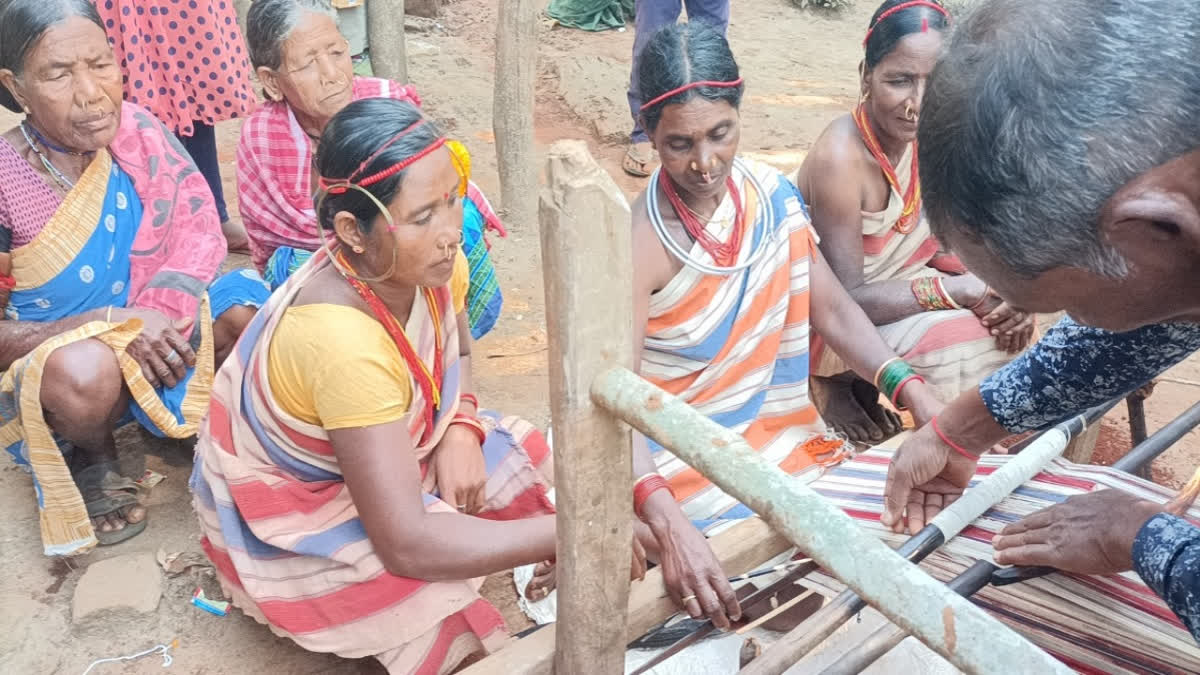Koraput/Bhubaneswar: For Sebati Sisa, 62, the capital city of Odisha did not matter for the time being. She seemed excited for the longer journey to New Delhi on Saturday to participate in an exhibition as a brand ambassador for the state's prized Kerang textile from a remote village in Koraput district. Dressed in wrap-around 'cropped' sarees in stripes of cyan, off white and orange - the typical colour combination seen only in Kerang weaves, Sebati, a Gadaba Adivasi woman, was eager to tell the story of the dying art, when ETV Bharat asked her on what hopes does she pin on the revival efforts.
"It is too early to say what will be the outcome of such revival efforts, but we survive on hope," says Sebati in Gutab dialect, typical to the Gadabas. She is currently among the older generation artists of the tribe, who are training the second and third generation Gadabas in the art of weaving the fabric.
Kerang fabric is passed down through generations as it does not wear and tear easily. It is usually gifted to a daughter when she gets married, but unless a girl or a boy in the tribe is trained to weave, they are not considered fit for marriage.
Four years back, the Indian National Trust for Art and Cultural Heritage (INTACH) initiated steps to keep the art form alive. Taking along the district administration, State Handicrafts and Handloom Department, Forest Department and most importantly, winning the trust of the Gadaba Adivasis, INTACH officials spoke to the families that knew the art of weaving Kerang. A loom house was built in Raipada village in Lamataput block of the district. Around 11 looms were set up for the older generation women to work on and train the youngsters.
The fabric woven by the villagers so far has been taken by the INTACH which also compensates them. "It is something between Rs 2000 and Rs 3000 for a 12 inch by 12 inch Kerang fabric," says an official accompanying them to New Delhi for the exhibition being curated by the INTACH. Sebati along with Moni Kirsani are the only two participants from Odisha chosen to represent the pride of their handwoven textile, Kerang, along with representatives from 29 different states.
THE PROCESS AND THE TOIL
When Sebati starts explaining the process, it keeps one wondering, how such marvelous works of art could be relegated to the edges of obscurity. The thread being the most important part, is made from a plant called Kerang. It is a slimy thin plant that is uprooted, and its stem dried under the sun after being beaten with a hammer umpteen times. Once dried, it is left to cool for a few days and then brought out and hammered to smithereens. From those split stems are the threads rolled which are then polished, by being rubbed against the skin of the artist.
"It is hell of a task to complete even one ball of thread. It takes us days to extract threads from the plants. First, not all plants can be used for the fabric as the older ones (3-4 year old) do not give quality threads. So we need to choose the younger plants only. But even then, Kerang thread alone does not make a fabric. We need 'dom suta,' another thread, to bind the Kerang,” explains Sebati.
The dom thread is then coloured with the help of Siuna and Jaffra - while Jaffra produces orange colour threads, Siuna yields blue, which are also fetched from plants by the same name. “We now spend about seven hours in the loom house each day. It takes a toll on our calf muscles as we wind and polish the threads around our legs,” says Sebati, showing the chapped skin on her legs. “One piece of Kerang takes us at least 15 days to weave,” she states, adding, “There are people from Bangalore and other parts of the country who buy these products from us for as much as Rs 10,000.”
